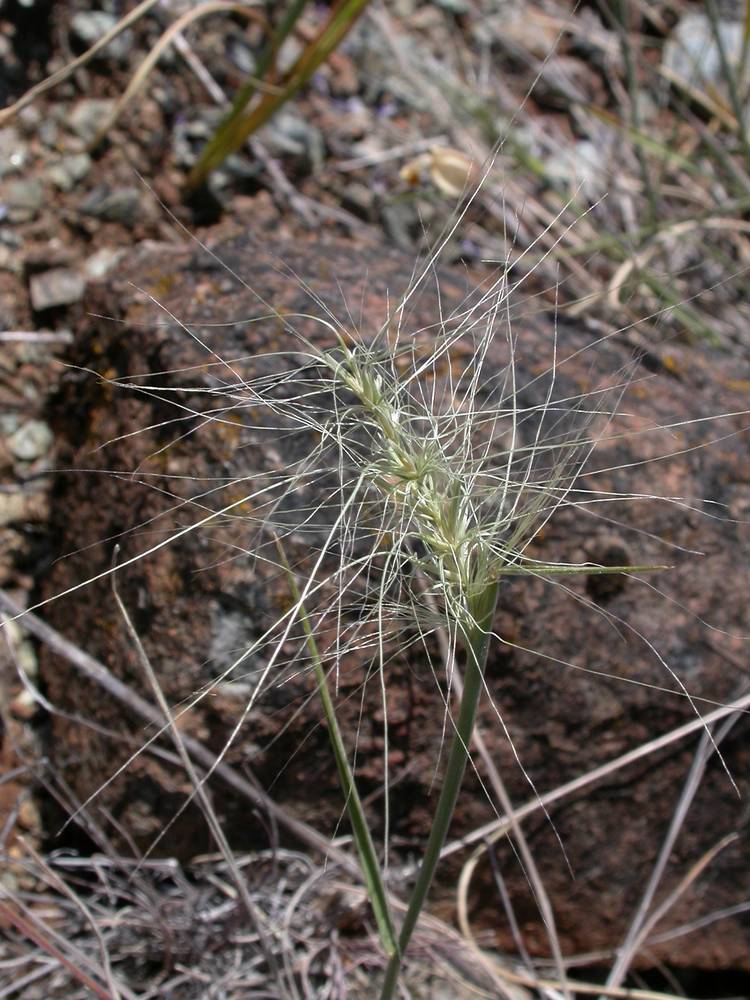Elymus multisetus
Elymus hirsutus
big squirreltail
northwestern wildrye
erect to ascending.
usually somewhat decumbent.
sheaths glabrous or white-villous;
blades 1.5–4 mm wide;
upper surfaces scabrous or hairy.
sheaths glabrous and smooth but occasionally minutely scabrous or hairy;
blades 4–12 mm wide;
upper surfaces pilose or villous but occasionally puberulent or minutely scabrous.
5–20 cm; erect, sometimes partially enclosed in the sheath of the uppermost leaf, 2 spikelets per node or rarely 3–4 at some nodes;
internodes 3–5(8)mm;
disarticulation initially at the rachis nodes; later beneath each floret.
6–20 cm, nodding to pendent, 2 spikelets per node or rarely with 3 at some nodes;
internodes 3–10(12) mm;
disarticulation above the glumes and beneath each floret.
10–15 mm, divergent, 2–4 florets; lowest florets sterile and glume-like in 1 or both spikelets at each node.
12–20 mm, appressed to divergent, 2–4(7) florets.
(10)30–100 mm including the awns; the bases hard and glabrous;
glume bodies about (2)5–10 × 1–2 mm, setaceous, 2–3-veined;
margins firm;
glume awns (8)25–90 mm; each split above the base into 3–9 unequal divisions, scabrous, flexuous to outcurving from near the bases at maturity.
(4.5)7–10(11) × 0.7– 1.5 mm, bases flat, occasionally hard for 0.5 mm;
veins usually evident, linear-lanceolate; entire, widening or parallel-sided above the base, 3–5-veined, usually scabridulous to scabrous;
veins occasionally hirsute beyond mid-length;
margins hyaline or scarious;
glume awns 1–10 mm; straight.
fertile lemmas 8–10 mm; smooth or scabrous near the tips, 2 lateral veins extending into bristles to 10 mm;
lemma awns (10)20– 110 × 0.2 mm at the base, divergent to arching.
7–14 mm; smooth or minutely scabrous;
lateral veins hairy;
margins hairy beyond mid-length; marginal hairs 0.5–1 mm and longer than those elsewhere on the lemma;
lemma awns (2)8–30 mm, flexuous to moderately outcurving.
1–2 mm.
2–3.5 mm.
=28.
Elymus multisetus
Elymus hirsutus
Dry, often rocky grasslands and savannas. 50–2000m. BR, Col, ECas, Lava, Sisk, WV. CA, ID, NV, WA; southeast to CO, south to Mexico. Native.
Elymus multisetus has inflorescences that fall apart at maturity and glumes that are divided into three to nine widely spreading awns. Very similar E. elymoides has glumes that are entire or unevenly split into two to three parts. Determining how much the glumes are split is complicated by the presence of glumelike sterile lemmas in both E. multisetus and some E. elymoides subspecies. Elymus multisetus glumes are divided above the base. If the glumes appear to be divided to the base, the plant is more likely to be E. elymoides.
Forest edges, thickets and grasslands near the coast and in coastal mountains. 0–1000m. CR, Est. WA; north to AK. Native.
The nodding spikes and ciliate lemma margins help identify Elymus hirsutus. The lemma margin hairs may be inconspicuous and should not be confused with the hairs sometimes present on the palea keels of Elymus species. Elymus hirsutus occasionally hybridizes with Elymus glaucus, Hordeum brachyantherum, and Leymus mollis.
Barbara Wilson, Richard Brainerd, Nick Otting
Barbara Wilson, Richard Brainerd, Nick Otting
- Local floras:
CA,
OR,
WA
- Local Web sites:
CalFlora,
CalPhotos,
Flora NW,
PNW Herbaria
WildflowerSearch
iNaturalist (observations)
USDA Plants Database
- LBJ Wildflower Center
- SEINet
- Plants of the World Online
- Encyclopedia of Life
- Wikipedia
- Google Image Search
- Local floras:
BC,
OR,
WA
- Local Web sites:
Flora NW,
PNW Herbaria
WildflowerSearch
iNaturalist (observations)
USDA Plants Database
- LBJ Wildflower Center
- SEINet
- Plants of the World Online
- Encyclopedia of Life
- Wikipedia
- Google Image Search




